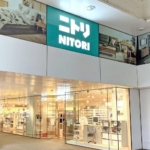10 Temples and Shrines in Japan with Heart Shapes 💗
♥Posted by Maiko♥
When you’re feeling a little down at work or in your personal life, heart motifs give you a little energy.♡
The heart mark is a symbol of good fortune that is said to have its origin in medieval Europe and is now loved all over the world. The heart shape is a mark that makes you feel energetic just by looking at it.

In fact, some shrines and temples in Japan have adopted heart-shaped designs. There are unexpectedly many temples and shrines where you can find hearts, and they are very popular among women.

So, how about a trip to visit shrines and temples with heart-shaped spots all over Japan?
It will give you energy and happiness.♪(´▽`)
Contents
Meiji Jingu | Tokyo
This is a huge shrine in Shibuya-ku, Tokyo. It is dedicated to Emperor Meiji and Empress Shoken. Every year, you can find hearts here and there in shrines where the number one worshipper in the country is Hatsumode.

The metal fittings of the gate also have a heart mark. These have meanings of talismans to ward off evil spirits and bring good fortune, and they are often used for metal fittings to hide wooden joints.

It is fun to look for one by one in the large precincts.ヾ(•ω•`)o

The most popular spot in Meiji Shrine is Kiyomasa no Ido (Kiyomasa’s Well). It is a natural spring well which is rare in the city center, and it is located in Meiji Jingu Gyoen.
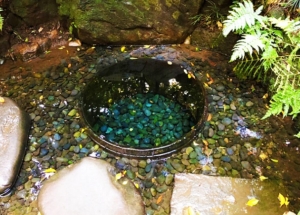
It is said to be a well dug by Kato Kiyomasa, a warlord in the Sengoku period, and 60 liters of spring water gushes out per minute. There is a charge to enter the Gyoen, but there is always a line.
For more information
Shojuin Temple | Kyoto
This is a temple in Ujitawara City, Kyoto Prefecture surrounded by peaceful Satoyama. And it is very popular because it has an impressive heart pattern.

Not only the cuteness of the window, but also the seasonal scenery such as cherry blossoms in spring, fresh green leaves in summer, azaleas in autumn, etc., are beautiful and look good in the picture!

Depending on the time, the sun may shine straight into the window and the two hearts may stand out clearly. You can see it in the evening, so please check the timing on a sunny day.♪

In addition to heart-shaped windows, the temple’s guest hall is filled with 160 ceiling paintings. The ceiling paintings depict Japan’s leading calligrapher Shoshu and “Flowers and Japanese Scenery.".

There are 4 pictures of Maiko in each season. Let’s look for them!
For more information
Suyamasengen Shrine | Shizuoka Pref.
This shrine at the foot of Mt. Fuji was registered as a World Cultural Heritage site in 2013 as a part of “Mt. Fuji – the object of worship and the source of art".

There is a stone lantern hollowed out in the shape of a heart, and you can see the mysterious view of the main shrine from the hole of the heart.(♡_♡)

This stone lantern is precious and was built in 1742. And yet, the gap of heart shape is also interesting.

The shrine is located at the start of the Suyamaguchi Trail, one of the trails on Mt. Fuji.

It is a hard mountain trail that passes by the primeval forest and Hoei crater group, but if you are a woman who loves mountain climbing, why don’t you try it at least once?
You can enjoy the magnificent nature of Mt. Fuji!
For more information
Ise Jingu | Mie Pref.
This is a famous shrine in Mie prefecture which consists of 125 shrines in total. There are sightseeing spots such as Okage Yokocho and Oharaimachi in the neighborhood.

This heart is on the stone wall of the underground passage that connects the municipal parking lot and Oharaimachi.
It is said that a craftsman inserted the accidental products made by nature into this.♥

After passing through Okage Yokocho and Oharaimachi, enter the worship area. Passing the wooden Uji-bashi Bridge over the Isuzugawa River, you will reach the sacred Inner Shrine.
Uji-bashi Bridge, which connects daily life and the sacred area, is a perfect spot for shooting because of its beautiful shape.

After visiting the shrine, why don’t you eat the freshly made Akafuku mochi in Okage Yokocho?

Akafuku is a well-established Japanese confectionery store established in 1707, and the Akafuku main store here is a magnificent wooden store.

The Akafuku mochi that you eat while looking at the thick interior is exceptional. By the way, the shape of Akafuku is based on the image of clear stream, Isuzugawa River.
For more information
Aisenji Temple | Ishikawa Pref.
This is a temple in Katayamazu Onsen town in Ishikawa prefecture. Isshin Ema with a red heart in the center is very popular here.

The red heart and Ema are separated, so we look for something that fits perfectly, write a wish, insert it and dedicate it. There are many women who put their wishes on cute Emas.♥

Isshin Ema
It is also the guardian temple of Katayamazu Onsen. The Goma-do hall on the temple grounds is dedicated to Aizen Myoo, the god of marriage, so women who wish for good luck in love often visit the shrine.

Shibayamagata, the symbol of Katayamazu Onsen, has a calm and tranquil atmosphere depending on the time. In the evening, the surface of the lake turns orange and Ukimi-do hall appears, making it very magical.(⓿_⓿)

You can see a different atmosphere from the view of the huge fountain in the daytime.
For more information
Tamukeyama Hachimangu Shrine | Nara Pref.
This is a shrine adjacent to the grounds of Todaiji. This shrine crest is called Mukaibato (facing pigeon), and the center of both pigeons looks like a heart, which is very cute.(≧∇≦)

It has a lovely atmosphere with the shrine crest of pigeons everywhere such as stone lanterns and Ema.

In this shrine, the torii on the north side is adjacent to the Todaiji Hokkedo Hall, and the torii on the south side is connected to the foot of Mt. Wakakusa.
A quiet shrine even though it is on the main route for sightseeing in Nara. It is a place where you can enjoy the atmosphere of the ancient capital, Nara.
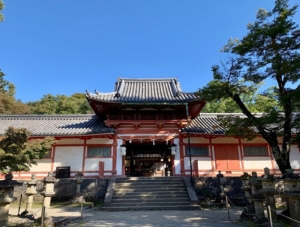
Let’s go to Todaiji Temple which is about 5 minutes walk from Tamukeyama Hachimangu Shrine. The Great Buddha is 15 meters tall and weighs 250 tons.

The head of the present Great Buddha was made in the Edo period, and most of its body was made in the Kamakura period, but some parts of the pedestal are from the 700’s when it was built.
For more information
Mimurotoji Temple | Kyoto
This is a temple in Uji city, and about 10,000 hydrangeas of 50 varieties are especially famous.

Sometimes you can find a heart-shaped hydrangea, and it is said that the person who finds it will fall in love.♡
You never know where the heart-shaped hydrangea blooms or what color it is, and only those who carefully look for it can find it. Please look for it in the mood of treasure hunting.(❤ ω ❤)

In the hydrangea garden in the precincts, there is a walking path to look around. The best time to see it every year is from the beginning of June, so why don’t you walk leisurely among the flowers?

The Uji City Tale of Genji Museum is a 20 minute walk from Mimurotoji Temple. There is a restored model of Hikaru Genji’s mansion in the building, and you can time travel to the elegant world of the Heian period.

For more information
Tofukuji Temple | Kyoto
This historic temple was built in the Kamakura period and is famous for its huge Sanmon gate and autumn leaves.
It is also known for having four beautiful gardens here.

There are unique gardens in each of the north, south, east and west in the Honbo garden. The north garden is a stylish garden with an impressive checkered pattern and has a heart-shaped azalea tree.
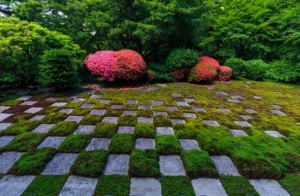
The azalea tree decorated with red flowers is surprisingly heart-shaped and very cute.(❁´◡`❁)

The south garden is the largest among the four, and it represents the world only with stones, and is popular among tourists from overseas.

Every garden is unique and photogenic, so I recommend you to see everything.
For more information
Ten Shrine | Tokushima Pref.
This is a shrine at the foot of Mt. Bizan, the symbol of Tokushima City.
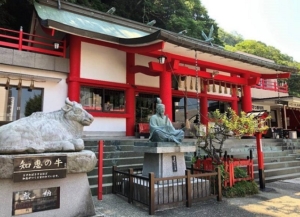
Himemiya Shrine, next to Ten Shrine, is said to bring benefits such as love fulfillment, matchmaking and a happy married couple. Hearts are scattered in the sacred area, such as a heart-shaped stone buried on the approach to the shrine.♡♥♡

This shrine has been called Himemiya-san for a long time, and it is a shrine where you can pray for pregnancy, easy delivery and recovery from illness. It is especially worshipped by local women.

Mt. Bizan, the symbol of Tokushima City, is a gentle mountain like a woman’s eyebrow. You can go to the top of the mountain by ropeway, and the night view of Tokushima city can be seen from the observatory of Bizan park where the station at the top of the mountain is located.

In the daytime, you can see Asan Mountains, Seto Inland Sea and Kishu mountains.
For more information
Mizuta Tenmangu | Fukuoka Pref.
This shrine is located on the grounds of Mizuta Tenmangu Shrine, one of the two great Tenmangu Shrines in Kyushu. It is known as the god of good match prayer and love fulfillment.

It is a shrine of love where the goshinmon is a heart and the torii also shines a heart.♪(^∇^*)

There is a stone lantern with a heart-shaped hole at the entrance of the approach. If you go further to the back of the approach, there is a pair of heart-shaped stone lanterns, so both are must-see!
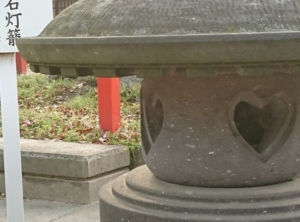
About 10 minutes by car from the shrine is a day trip hot spring called Koibotaru. The quality of the hot spring is magnesium sodium bicarbonate spring, and it is said to be “hot spring for beautiful skin" that is effective for beautiful skin.

There is a free foot bath in the site, so why don’t you stop by on your way back from worshipping?
For more information
Hearts are not only cute, but also fit in with people’s feelings. Let’s find the Japanese traditional heart mark and enjoy the trip to pray for good luck.(♥◕‿ ◕♥)

Sankoinari Shrine | Aichi Pref.
I hope it will be a trip that heals your heart and makes you more feminine.
8 Items That Will Make Your Trip on the Shinkansen Fun 🎵













